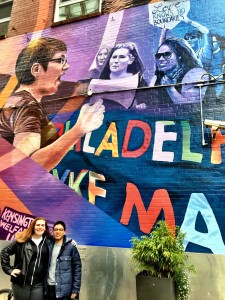Professor Mercado and I spoke earlier this week about our upcoming visit to the Philadelphia History Truck and about other Philly based initiatives. I was explaining a story about the Gloria Casarez mural on 12th and Locust in which the Philly Mural Arts Program censored the design so as not to include the word dyke as a part of the “Philadelphia Dyke March” (PDM) banner featured in the mural. As a long time PDM activist (who maintains our organizational memory) it personally feels like an ESSENTIAL part of the recorded history of this mural. Professor Mercado casually mentioned the process of push and pull about what contextual information needs to be documented & where. Why do I feel like that needs to be documented while at the same time not having the organizational structure to maintain a public record?
The omission of “dyke” felt so important to me as Gloria’s vision for founding of PDM was as a radical collective who have reclaimed “dyke” for almost 20 years. But what if it only means something to me? What if the larger movement wouldn’t really gain much from adding half a letter on to a mural that is already a major accomplishment. Why am I so concerned? Am I just imagining that omissions like these are signals of the deep foundational injustice within my own LGBT community? I have been replaying this notion of irrelevance to the larger story over and over this week and the readings certainly spoke to my internal ethical dilemma. What if no one even notices the altered history of the mural. Who are you accountable to and what say do you really have when someone other org is funding your work? Public historians like Bernard seemed to often struggle with how to comfort and simultaneously empower change makers in the face of their invisible emotion work.
Part of Gloria’s Mural edited post production to get ride of “Dyke March”
This quote summed it up for me:
Bernard writes: “The issue I see in a dovelike existence is the potential to run interference to community building even when we most desire a positive outcome. Even if we embrace the dove as a symbol for socially engaged artists, we are not without a complex journey. Nato Thompson wrote recently in Seeing Power, ‘In order to produce a new community, we must thus not only consider inherent notions of privilege, but also attempt to see power from the position of those who we are organizing with, and vice versa’ (2015: 125).
I definitely identify as one of the community builders Bernard writes about based in Philly. I want to apply the work we have learned in this course to my community friends but I am often unsure how to start the conversation and deal with the disappointment.
I also understand that in some situations, listening and “considering” elements of queer life is a good copout for a lot of straight allies dealing with who can’t get over their conflicting feelings about participating in LGBT events. So does that mean we need to be the organizers, historians, outreach, and doing the grunt work for a space that we can’t even participate in? Angela wrote “I don’t think that it’s up to the people to continue the history, because so many other things are pressing down on them. But I do think that it’s important for them to have a voice in the way that their history is remembered. I’m trying to grapple with this idea- I want history to be remembered through the voices of those living in it, but I don’t want the pressure to be on the people to recount the events, especially when so many other things are going on.
Things like the truck are a new an inventive way to bring the history to the people. I must admit that when I heard such a project existed I was incredibly excited. The Philadelphia that I moved to 9 years ago fresh out of high school is a very different place than the city I interact with now. (I am unsure if it’s my perception of the changing landscape of our city is just my sociological lens on overdrive.)
I hope that tomorrow she can expand on the notion that, “For many doves, and for many social practice artists, we are not able to completely digest the lived experiences of those with which we work. How can we see the issues of power that our community collaborators face? Are we able to meet grassroots partners where they are without distorting their work with our own creative vision? How can we grapple with our own aesthetic intentions and the needs of our community relations?
I am not sure that I have complete answers to these questions, but I do believe that History Truck is at it’s best when it lifts up the work of others. I also know that it is impossible to avoid moments of friction where the interests as of public historian do not exactly meet the needs of those change makers work with in Philadelphia neighborhoods and I am excited to learn more about how they bridge those divides tomorrow.


Yes, I’m troubled by these questions too, or, at least, up at night thinking about them! “How do we lift up the work of others?” How do we take on, as you also write, “start[ing] the conversation and deal[ing] with the disappointment” ? I can’t stop thinking about our conversation last week, started by Sofi’s post, about emotional labor and public history, and I don’t think that conversation is ending anytime soon.